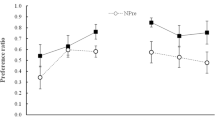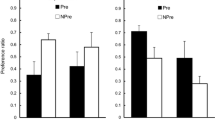Abstract
Three experiments are reported which addressed the possibility that a neutral-flavor stimulus (CS2) can become aversive by pairing it with a previously established aversive-flavor stimulus (CS1). Unlike previous higher-order conditioning studies in which CSl followed CS2 (CS2-CS1 pairings), the present studies reversed this order (CS1-CS2 pairings) to determine the extent that backward second-order conditioning produces an aversion to CS2. In Experiment 1, rats received zero, one, or three pairings of a walnut-flavored solution (CS1) with LiCI. The walnut flavor was then presented just prior to forced consumption of a neutral lemon-flavored solution (CS2). A significant aversion developed to lemon only when three walnut-LiCI pairings were used. Experiment 2 manipulated the flavors used as CS1 and CS2 (lemon or walnut). Results indicated that regardless of the flavors used, a significant aversion developed to CS2 as a result of CS1-CS2 pairings. In Experiment 3, the level of aversion to CS2 with the backward higher-order conditioning paradigm was compared to forward higher-order conditioning. An unconditioned stimulus (UCS) alone treatment and a handling control treatment were included to evaluate the level of neophobia to novel flavors. Results showed that the percentages of CS2 (lemon) flavor consumed relative to total consumption was significantly lower in the backward higher order conditioning group than in the UCS alone and handling control treatments. The forward higher-order conditioning group was quite variable and differed from the control groups at the.08 level. These findings are discussed in terms of higher-order conditioning and flavor aversion learning.
Similar content being viewed by others
References
BEST, P. J., BEST, M. R., & MICKEY, G. A. (1973). Conditioned aversion to distinct environmental stimuli resulting from gastrointestinal distress. Journal of Comparative and Physiological Psychology, 85, 250–257.
DOMJAN, M., & GREGG, B. (1977). Long-delay backward taste-aversion conditioning with lithium. Physiology and Behavior, 18, 59–62.
GORDON, W. C. (1981). Mechanisms of cue-induced enhancement. In N. E. Spear & R. R. Miller (Eds.), Information processing in animals: Memory mechanisms. Hillsdale, NJ: Erlbaum
GORDON, W. C. (1983). Malleability of memory in animals. In R. L. Mellgren (Ed.), Animal cognition and behavior. New York: North Holland.
GORDON, W. C., MCGINNIS, C. M., & WEAVER, M. S. (1985). The effect of cueing after backward conditioning trials. Learning and Motivation, 16, 444–463.
HETH, C. D., & RESCORLA, R. A. (1973). Simultaneous and backward fear conditioning in the rat. Journal of Comparative and Physiological Psychology, 82, 434–443.
KAMIN, L. J. (1963). Retention of an incompletely learned avoidance response: Some further analysis. Journal of Comparative and Physiological Psychology, 56, 713–718.
KIMBLE, G. A. (1961). Hilgard and Marquis’ conditioning and learning. New York: Appleton-Century-Crofts.
KLEIN, S. B., MIKULKA, P. J., & HAMEL, K. (1976). Influence of sucrose preexposure on acquisition of a conditioned aversion. Behavioral Biology, 16, 99–104.
LINDQUIST, E. F. (1956). Design and analysis of experiments in psychology and education. Boston: Houghton-Mifflin.
RESCORLA, R. A. (1981). Pavlovian second-order conditioning. Hillsdale, NJ: Erlbaum.
RESCORLA, R. A., & CUNNINGHAM, C. L. (1978). Within compound flavor associations. Journal of Experimental Psychology: Animal Behavior Processes, 4, 267–275.
RIZLEY, R. C., & RESCORLA, R. A. (1972). Associations in higher order conditioning and sensory preconditioning. Journal of Comparative and Physiological Psychology, 81, 1–11.
SPETCH, M., WILKIE, D., & PINEL, J. (1981). Backward conditioning: A reevaluation of the empirical evidence. Psychological Bulletin, 89(1), 163–175.
SIEGEL, S., & DOMJAN, M. (1971). Backward conditioning as an inhibitory procedure. Learning and Motivation, 2, 1–11.
WAGNER, A. R., & TERRY, W. S. (1975). Backward conditioning to a Cs following an expected vs. a surprising Ucs. Animal Learning and Behavior, 3, 370–374.
Author information
Authors and Affiliations
Rights and permissions
About this article
Cite this article
Mowrer, R.R., Krug, D.E. & Klein, S.B. Backward Second-Order Conditioning in Flavor Aversion Learning. Psychol Rec 38, 259–269 (1988). https://doi.org/10.1007/BF03395022
Published:
Issue Date:
DOI: https://doi.org/10.1007/BF03395022




